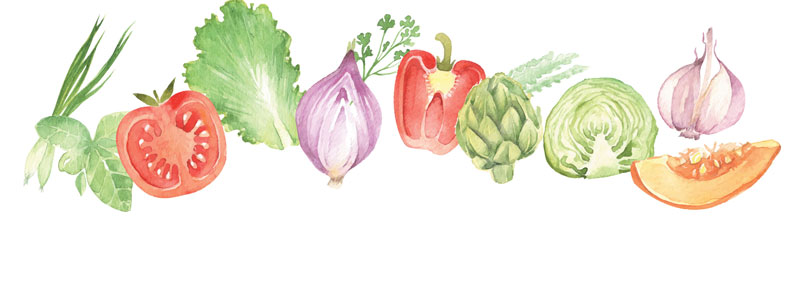Whether you are a CSA member, grow your own garden, or shop at farmer’s markets, maximizing the summer harvest is an important objective. Much is written about ways of preserving surplus produce such as canning, fermentation, dehydration, and freezing. I thought I would take a different approach and discuss ways to expand your use of the summer bounty at its freshest—here and now.
Eat Vegetables for Breakfast
The paradigm of the American breakfast has long been refined carbohydrates, sugar, and meat (bacon, eggs). Note the distinct lack of vegetables. Try a salad topped with a fried egg or toast smothered with sautéed bitter greens and egg. Make extra grilled veggies and serve a veggie hash with eggs at your brunch table. Or completely break out of the box and try fresh gazpacho or a Caprese salad as your morning eye-opener. There are no breakfast police, so let down your guard and get creative with breakfast foods.
Add More Vegetables to Your Recipes
Most recipes cater to the standard American diet, which is high protein and carbohydrates, and low in vegetables. Even casserole recipes that contain veggies actually include very few vegetables (and a narrow variety to boot). I recently cooked a curry stir-fry followed loosely from a typical recipe that included about 20% percent vegetables and 80% chicken. I used five times the amount of vegetables and added a quarter of the amount of chicken. The result was a veggie-centric, wholly delicious dish that completely cleaned out my fridge of produce. This works even for dishes you wouldn’t normally think to add veggies to, like taco meat sautéed with grated zucchini, Bolognese sauce made with finely diced carrot, turnip, and zucchini, or macaroni and cheese brimming with broccoli.
Get Creative
Nothing jams my flow like food boredom. It is so easy to get in food ruts, and when we eat the same thing day in and day out our bodies naturally crave something different. That is when I find the zucchini rotting on the counter because I just can’t stomach (literally) another stuffed zucchini. Changing up textures or using different cooking methods can alter the flavor and “feel” of food so much that it can seem like a different item altogether.
Here are some of my creative go-to’s:
- Make “chips” or fries. Using a mandolin, thinly slice your vegetables, toss with oil and spices, and bake at 350 or 400 until lightly browned and/or crisp. This works well for beets, sweet potatoes, zucchini, Brussels sprouts, and parsnips. Alternatively, make baked fries (I especially love rutabaga, kohlrabi, parsnip and zucchini fries)
- Experiment with the grill—Cucumbers, watermelon slices, salad greens, radicchio, kale, okra, green beans and cabbage, while not typically thought of as grill items, are all terrific on the grill. You might be sick of your garden- variety salad, but have you tried a grilled Caesar salad?
- Spiralize—New gadgets called spiralizers cut long, noodle-like pieces from zucchini, summer squash, cucumber, potato, sweet potato, large carrots, or turnips. Left raw or lightly sautéed, these “noodles” can take the place of pasta or add special interest to a dish. My husband loves spiralized zucchini tossed with marinara and spaghetti. The zucchini gives the dish a unique crunch and sweetness, yet it doesn’t taste like zucchini.
- “Rice” it—Paleo and raw enthusiasts have embraced a wonderful technique for “ricing” vegetables, which is used as a substitute for grains in dishes. Simply put, items like cauliflower, root vegetables, zucchini, summer squash, and winter squash are pulsed in a food processor until they resemble rice. The riced veggies are then either lightly cooked or left raw and used in anything from “fried rice” to “grain salads”. One of my favorite riced meals is “tabouli” made with raw riced cauliflower combined with parsley, tomato, cucumber, fresh squeezed lemon juice, and olive oil. The dish doesn’t taste like cauliflower and yet is surprisingly similar to tabouli made with bulgur.
- Make smoothies, juices, and other beverages—Juicers, which are increasingly affordable, offer another excellent way to use up large amounts of vegetables all at once. Fresh vegetable juices can be consumed as is, or used in salad dressings, marinades, cold soups, or as a base for other beverages (even cocktails like cucumber gimlets). I use my plethora of homegrown mint and cucumber each season by keeping a pitcher of infused cucumber-mint water in the fridge at all times.
- Make pesto—There are hundreds of possible pestos made from herbs; kale, arugula or other greens; carrot tops; roasted peppers; beets; broccoli or broccoli stems; carrots; zucchini; and fresh peas. Pesto is fantastic mixed with pasta (or spiralized “noodles”), made into a dip, served as a condiment for meats, stirred into soup/stews, made into vinaigrettes, mixed with grains or “rices”, stirred into fillings or stuffings, or incorporated into crostini appetizers.
- Add veggies to baked goods—Pureed or shredded veggies add moisture, interest, texture, and nutrition to baked goods like muffins and breads. Substitute parsnips for carrots in carrot cake or try pureed beets in brownies!
Don’t be overwhelmed by a productive harvest. Creative, produce-inspired recipes abound on the internet. Put your Googling skills to good use and check them out today.
Julie Wern is a psychologist turned stay-at-home-mom turned caterer. She is currently in training at the Institute of Integrative Nutrition to become a nutrition and wellness coach. She is the author of Holcomb Farm CSA’s Simply Fresh blog and currently teaches cooking and cookie decorating classes. Contact Julie at jwern@comcast.net for comments and inquiries.
